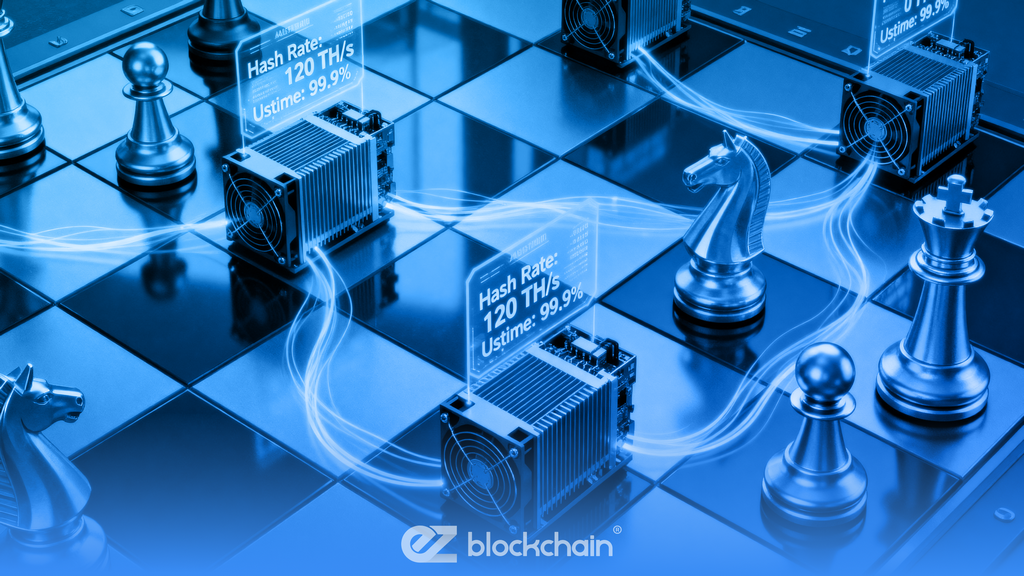Stay up to date with the latest news, announcements, and articles.
- What Is Kaspa and Why It’s Gaining Popularity
- Key Factors When Choosing a Kaspa Miner
- Top Kaspa Miner Models
- Antminer KS5 Pro
- Iceriver KS1
- Goldshell KS0 Pro
- Bitmain KS3
- Future of Kaspa Mining
- Efficiency and Power Consumption Comparison
- Profitability Outlook for Kaspa Miners
- Maintenance and Cooling Tips
- Regular Cleaning
- Airflow and Cooling
- Temperature Monitoring
- Thermal Paste Maintenance
- Firmware Updates
- Kaspa Mining Pool Strategies
- Where to Buy Reliable Kaspa Miners
- FAQ
- What is the best Kaspa miner for beginners?
- Can I use a GPU for Kaspa mining?
- How much electricity does a Kaspa ASIC miner consume?
- Is Kaspa mining profitable in 2025?
- How do I maintain my Kaspa mining rig?
This guide evaluates the top Kaspa miners on the market, analyzing technical specifications, efficiency, power consumption, and projected profitability.
What Is Kaspa and Why It’s Gaining Popularity
Kaspa (KAS) is a high-throughput cryptocurrency built on a blockDAG (Directed Acyclic Graph) architecture, which allows multiple blocks to be confirmed simultaneously. Unlike linear blockchains such as Bitcoin, Kaspa’s DAG structure reduces confirmation times and improves network scalability without compromising decentralization.
- Block generation occurs approximately every 1 second, compared to Bitcoin’s 10 minutes (Kaspa Foundation, 2023).
- The kHeavyHash algorithm optimizes mining for ASIC hardware, enhancing network security.
- DAG-based design allows high transaction throughput, making Kaspa suitable for both small-scale and industrial mining operations.
This combination of speed, network efficiency, and ASIC optimization has fueled Kaspa’s adoption among cryptocurrency miners and investors.

Key Factors When Choosing a Kaspa Miner
Selecting the best Kaspa miner requires evaluating both technical and financial metrics. Key considerations include:
- Hashrate: Determines the miner’s computational power. A higher hashrate increases the likelihood of solving blocks and earning rewards.
- Power Efficiency: Measured in joules per gigahash (J/GH). Efficient miners reduce electricity costs and enhance long-term profitability.
- Cooling Requirements: Efficient thermal management is essential to maintain performance and prevent hardware degradation.
- Noise Levels: Some miners operate louder than others, which may affect deployment location choices.
- Initial Cost & ROI: Balancing upfront cost with expected returns is critical. ROI is influenced by KAS price, network difficulty, and electricity costs.
Careful consideration of these factors ensures miners select hardware that maximizes long-term gains.
Top Kaspa Miner Models
Antminer KS5 Pro
The Antminer KS5 Pro is Bitmain’s flagship Kaspa ASIC miner, delivering a 25 GH/s hashrate at 3100 W. Its J/GH efficiency of 124 positions it as a leading choice for industrial-scale operations.
- Features dual cooling fans with adjustable RPM to maintain optimal temperature.
- Compact modular design allows easy scalability in mining farms.
- Firmware supports remote monitoring and real-time hash rate tracking.
Pros: High hashrate, proven reliability, advanced thermal design.
Cons: High upfront cost, requires professional electrical setup.
Iceriver KS2
The Iceriver KS2 provides 20 GH/s at 2800 W, with efficiency around 140 J/GH. Its design is compact, making it ideal for medium-scale operations.
- Features optimized heat sinks and quiet fan operation.
- Supports automatic frequency tuning for stability.
Pros: Lower cost than KS5 Pro, moderate power draw.
Cons: Slightly lower efficiency, needs consistent cooling airflow.
Iceriver KS1
The Iceriver KS1 is an entry-level Kaspa ASIC miner, offering 12 GH/s at 1800 W. Suitable for small miners or experimental setups.
- Lightweight design with plug-and-play setup.
- Firmware includes basic monitoring tools for hash rate and temperature.
Pros: Affordable, easy to set up.
Cons: Limited hashrate, slower ROI for large-scale mining.
Goldshell KS0 Pro
Goldshell KS0 Pro provides 15 GH/s at 2000 W. It is designed for efficiency and minimal noise, ideal for home-based or small office mining operations.
- Features integrated thermal sensors for real-time heat monitoring.
- Low vibration fans reduce mechanical noise.
Pros: Efficient, quiet, compact footprint.
Cons: Older architecture may limit future firmware updates.
Bitmain KS3
The Bitmain KS3 offers 18 GH/s at 2600 W, balancing performance and cost. Its industrial-grade chips ensure reliability under continuous operation.
- High-quality PCB design reduces risk of failure.
- Dual-fan cooling and adjustable fan speed optimize temperature control.
Pros: Trusted manufacturer, strong performance.
Cons: Moderate power consumption, requires good airflow.

Future of Kaspa Mining
Kaspa mining is expected to expand as the network grows and adoption increases. Analysts predict higher KAS token value and incremental network difficulty will favor miners using high-efficiency ASICs.
Emerging trends include:
- AI-assisted mining optimization for better hash efficiency.
- Remote management platforms for large-scale miner deployment.
- Advanced cooling solutions including liquid cooling for industrial miners.
Efficiency and Power Consumption Comparison
| Miner Model | Hashrate (GH/s) | Power (W) | Efficiency (J/GH) |
| Antminer KS5 Pro | 25 | 3100 | 124 |
| Iceriver KS2 | 20 | 2800 | 140 |
| Iceriver KS1 | 12 | 1800 | 150 |
| Goldshell KS0 Pro | 15 | 2000 | 133 |
| Bitmain KS3 | 18 | 2600 | 144 |
This table highlights efficiency versus performance trade-offs. Large-scale operations benefit from the KS5 Pro’s superior hashrate, while smaller miners may prioritize energy efficiency with the Goldshell KS0 Pro.
Profitability Outlook for Kaspa Miners
Using a KAS price of ~$0.033 (2025) and electricity at $0.12/kWh, profitability estimates are:
- Antminer KS5 Pro: ~$8–$10/day
- Iceriver KS2: ~$6–$7/day
- Iceriver KS1: ~$3–$4/day
- Goldshell KS0 Pro: ~$4–$5/day
- Bitmain KS3: ~$5–$6/day
Factors influencing profitability include:
- Network difficulty and total hashrate.
- KAS price volatility.
- Electricity and cooling costs.
Mining calculators like WhatToMine or ASIC Miner Value can provide detailed ROI projections.
Maintenance and Cooling Tips
Effective maintenance prolongs hardware lifespan and ensures consistent hash rates.
Regular Cleaning
Dust accumulation on mining hardware can significantly impair heat dissipation, leading to elevated operating temperatures and potential hardware failure. To mitigate this, miners should be cleaned at regular intervals using compressed air or specialized anti-static brushes. Particular attention should be paid to the fans, heat sinks, and ventilation channels, as even minor obstructions can compromise airflow and thermal efficiency. Regular maintenance reduces the risk of thermal throttling and ensures stable operational performance.
Airflow and Cooling
Optimal airflow is critical for maintaining safe operating temperatures. Mining setups should be configured to allow unobstructed air intake and exhaust. In high-density mining environments or regions with elevated ambient temperatures, supplemental cooling solutions—such as external cooling units, liquid cooling systems, or dedicated air conditioning—should be employed. Properly managed airflow prevents hotspots, extends component lifespan, and maintains consistent hash rates.
Temperature Monitoring
Monitoring the temperature of critical components, including chips and printed circuit boards (PCBs), is essential for early detection of potential thermal issues. Firmware tools and hardware monitoring software can provide real-time temperature readings and trigger alerts if thresholds are exceeded. Proactive monitoring allows operators to respond to overheating conditions before they result in irreversible damage or performance degradation.
Thermal Paste Maintenance
The application of high-quality thermal paste between chips and heat sinks is essential for efficient heat transfer. Over time, thermal paste can dry out or degrade, reducing its thermal conductivity. Periodic replacement ensures that the heat generated by chips is effectively conducted to cooling surfaces, maintaining operational efficiency and preventing localized overheating.
Firmware Updates
Firmware updates are not only critical for addressing security vulnerabilities but also for enhancing operational efficiency. Manufacturers frequently release updates that optimize hashing algorithms, improve thermal management, and enhance hardware stability. Ensuring firmware is current can prevent malfunctions, increase mining efficiency, and extend hardware lifespan.
Kaspa Mining Pool Strategies
Joining a mining pool can stabilize income:
- Choose pools with low fees and reliable uptime.
- Consider PPS+ (Pay Per Share Plus) models for consistent rewards.
- Diversify pool participation to reduce risk.
Pooling is especially recommended for small and medium-scale miners to reduce variance in daily payouts.

Where to Buy Reliable Kaspa Miners
- Official manufacturers: Bitmain, Iceriver, Goldshell.
- Authorized resellers listed on EZBlockchain.
- Verified marketplaces with warranty support.
Always verify authenticity, warranty coverage, and seller reputation to avoid counterfeit hardware.
FAQ
What is the best Kaspa miner for beginners?
The Iceriver KS1 is recommended for beginners due to its affordability, energy efficiency, and manageable noise levels. Its low power consumption ensures that new miners can experiment without high electricity costs, while its simple setup process allows easy integration into small-scale mining rigs. For home miners, KS1 is a practical starting point before scaling up to more powerful models.
Can I use a GPU for Kaspa mining?
While GPUs can technically mine Kaspa, ASIC miners are far more efficient. GPUs consume more electricity relative to the hash rate, making them less cost-effective. ASIC miners like Antminer KS5 Pro or Iceriver KS2 are optimized for the KAS algorithm, providing significantly higher profitability and consistent network performance.
How much electricity does a Kaspa ASIC miner consume?
Electricity consumption varies by model, ranging from 950W (Goldshell KS0 Pro) to 3400W (Antminer KS5 Pro). Energy costs are a major factor in mining profitability, so selecting an efficient miner and optimizing cooling can substantially reduce operational expenses over time. Many miners also consider ambient temperature and power pricing to calculate precise ROI.
Is Kaspa mining profitable in 2025?
Yes, provided miners choose efficient ASIC models, join active mining pools, and manage electricity costs effectively. Market conditions such as KAS token price and network difficulty will influence returns, but data from CryptoCompare 2024 suggests that mid-range miners can still achieve 25–30% ROI under optimal conditions. Strategic planning and up-to-date hardware selection are essential for long-term profitability.
How do I maintain my Kaspa mining rig?
Regular maintenance is crucial. Clean dust from fans and heatsinks, apply thermal paste periodically, keep the ambient temperature within optimal ranges, and install firmware updates. Neglecting maintenance can lead to overheating, reduced hash rate, and potential hardware failure, which directly impacts mining income.
Fill out a form and our bitcoin mining expert will contact you.
FREE CONSULTATIONchoose
a miner
profit and
understand data?
business remotely
with EZ Blockchain?
Fill out a form and our bitcoin mining expert will contact you.









